University Report: Contemporary Developments in Employment Relations
VerifiedAdded on 2021/02/20
|15
|5028
|562
Report
AI Summary
This report provides a comprehensive analysis of contemporary developments in employment relations. It begins by defining employment relations and comparing unitarist and pluralist approaches, examining factors that impact the employer-employee relationship. The report then delves into the key features of employment contracts, explores UK and EU employment law, and discusses major legal developments. It offers recommendations on statutory trade union recognition, and investigates employee involvement, participation, and partnership, including union and non-union representation and the link between employee voice and organizational performance. Furthermore, the report differentiates between conflicts and misbehavior, official and unofficial industrial actions, and assesses contemporary trends in conflict and sanctions. Finally, it provides insights into skills for managing grievances and disputes, and the differences between conciliation, mediation, and arbitration, offering a holistic view of modern employment relations.
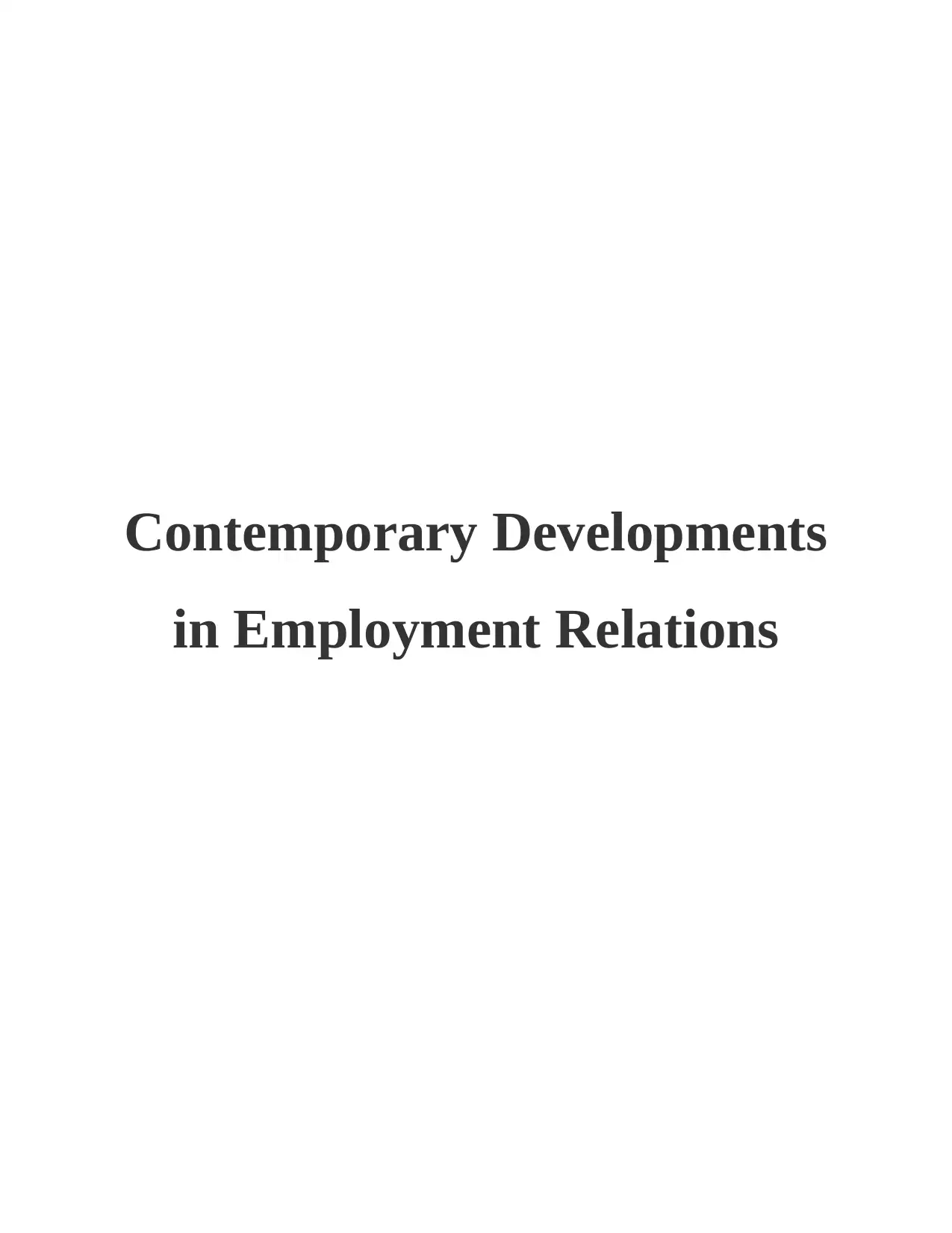
Contemporary Developments
in Employment Relations
in Employment Relations
Paraphrase This Document
Need a fresh take? Get an instant paraphrase of this document with our AI Paraphraser
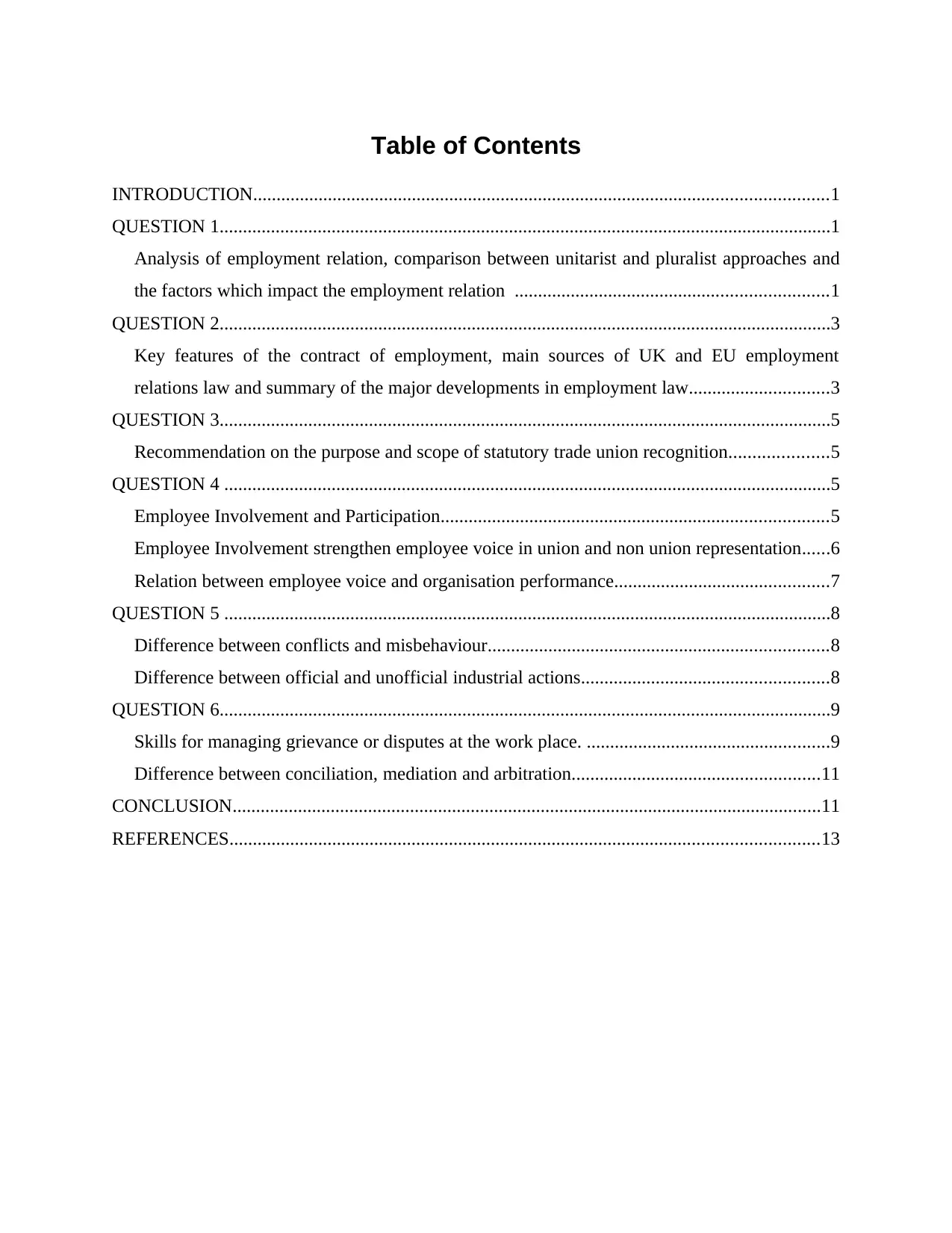
Table of Contents
INTRODUCTION...........................................................................................................................1
QUESTION 1...................................................................................................................................1
Analysis of employment relation, comparison between unitarist and pluralist approaches and
the factors which impact the employment relation ...................................................................1
QUESTION 2...................................................................................................................................3
Key features of the contract of employment, main sources of UK and EU employment
relations law and summary of the major developments in employment law..............................3
QUESTION 3...................................................................................................................................5
Recommendation on the purpose and scope of statutory trade union recognition.....................5
QUESTION 4 ..................................................................................................................................5
Employee Involvement and Participation...................................................................................5
Employee Involvement strengthen employee voice in union and non union representation......6
Relation between employee voice and organisation performance..............................................7
QUESTION 5 ..................................................................................................................................8
Difference between conflicts and misbehaviour.........................................................................8
Difference between official and unofficial industrial actions.....................................................8
QUESTION 6...................................................................................................................................9
Skills for managing grievance or disputes at the work place. ....................................................9
Difference between conciliation, mediation and arbitration.....................................................11
CONCLUSION..............................................................................................................................11
REFERENCES..............................................................................................................................13
INTRODUCTION...........................................................................................................................1
QUESTION 1...................................................................................................................................1
Analysis of employment relation, comparison between unitarist and pluralist approaches and
the factors which impact the employment relation ...................................................................1
QUESTION 2...................................................................................................................................3
Key features of the contract of employment, main sources of UK and EU employment
relations law and summary of the major developments in employment law..............................3
QUESTION 3...................................................................................................................................5
Recommendation on the purpose and scope of statutory trade union recognition.....................5
QUESTION 4 ..................................................................................................................................5
Employee Involvement and Participation...................................................................................5
Employee Involvement strengthen employee voice in union and non union representation......6
Relation between employee voice and organisation performance..............................................7
QUESTION 5 ..................................................................................................................................8
Difference between conflicts and misbehaviour.........................................................................8
Difference between official and unofficial industrial actions.....................................................8
QUESTION 6...................................................................................................................................9
Skills for managing grievance or disputes at the work place. ....................................................9
Difference between conciliation, mediation and arbitration.....................................................11
CONCLUSION..............................................................................................................................11
REFERENCES..............................................................................................................................13

INTRODUCTION
Employment relation is the human resource method which includes honest, fair and
consistent treatment of all the workers by leaders to increase their loyalty towards their jobs and
firm and is also defined as attempt of company towards maintenance of relationship of the
employees and the manager to prevent rising issues or conflicts from different situations at
workplace so that the organisation can focus on its goals and objectives. This file will discuss
about indeterminate nature of employee relation, and it will compare between unitarist and
pluralist approaches of employee relation along with discussing factors which are affecting on
employment relation. This report will also include essential features of the contract of
employment
and analysis of the main sources of UK and EU employment relations law-making with
explaining the main developments in individual employment law and notifying the purpose and
scope of statutory trade union recognition. This will also highlight the differences in employee
involvement, participation and partnership, comparison between union and non-union forms of
employee representation with describing link between employee voice and organisation
performance. Lastly this report will focus on differences between conflict and misbehaviour, and
between official and unofficial industrial action with assessing contemporary trends in the types
of conflict and industrial sanctions. It will also advise skills to managers for effective grievance
and dispute handling procedures and will give differences between third-party conciliation,
mediation and arbitration (Marginson 2016).
QUESTION 1
Analysis of employment relation, comparison between unitarist and pluralist approaches and the
factors which impact the employment relation
Employment relations :
The relation between the employer and the employees is known as the employee relation.
If an organization is having good relations programs in their company it helps them to provide
equal and fair treatment to each employee this will increase the loyalty and job satisfaction of the
employees towards the company. The employment relation is among the more complex,
complicated and delicate problem within the society of modern industry. The nature of
employment relation are as follows
Employment relation is the human resource method which includes honest, fair and
consistent treatment of all the workers by leaders to increase their loyalty towards their jobs and
firm and is also defined as attempt of company towards maintenance of relationship of the
employees and the manager to prevent rising issues or conflicts from different situations at
workplace so that the organisation can focus on its goals and objectives. This file will discuss
about indeterminate nature of employee relation, and it will compare between unitarist and
pluralist approaches of employee relation along with discussing factors which are affecting on
employment relation. This report will also include essential features of the contract of
employment
and analysis of the main sources of UK and EU employment relations law-making with
explaining the main developments in individual employment law and notifying the purpose and
scope of statutory trade union recognition. This will also highlight the differences in employee
involvement, participation and partnership, comparison between union and non-union forms of
employee representation with describing link between employee voice and organisation
performance. Lastly this report will focus on differences between conflict and misbehaviour, and
between official and unofficial industrial action with assessing contemporary trends in the types
of conflict and industrial sanctions. It will also advise skills to managers for effective grievance
and dispute handling procedures and will give differences between third-party conciliation,
mediation and arbitration (Marginson 2016).
QUESTION 1
Analysis of employment relation, comparison between unitarist and pluralist approaches and the
factors which impact the employment relation
Employment relations :
The relation between the employer and the employees is known as the employee relation.
If an organization is having good relations programs in their company it helps them to provide
equal and fair treatment to each employee this will increase the loyalty and job satisfaction of the
employees towards the company. The employment relation is among the more complex,
complicated and delicate problem within the society of modern industry. The nature of
employment relation are as follows
⊘ This is a preview!⊘
Do you want full access?
Subscribe today to unlock all pages.

Trusted by 1+ million students worldwide

The existence of the employment relation depend on two parties – employees and
employers.
The relationship between the employer and employees changes when the structure and
the environment of organization.
Both collective and individual relations are included in the employment relations
This relationship is developing and dynamic concept(Liao,Wayne and Rousseau 2016).
There is involvement of various parties in the employment relations system.
The purpose of these relation is to maintain a proper relation between the worker and
management of the company.
Employment relation is the result of the relation between the employers and the
employees based on their attitudes towards each other.
Comparison between Unitarist and pluralist approaches :
BASIS Unitarism Pluralism
Meaning It is overview which highlight the
interest which is shared between
employees and employer
It is an overview of different
departments and their legitimate
interest in the organization.
Goals and interest The goals and the interest in the
type is common
There is a possibility to have
different goals and interests
Conflicts Conflict are not adaptive in this
method
The conflict are acceptable and they
arise regularly
Paternalistic
Approach
The method has paternalistic
approach and the loyalty among the
employees are expected
This method does not have the
paternalistic approach as well as the
loyalty of employees are not
expected(Stokes and Wood 2016).
The factors which impact the employment relation :
Communication : This is the most important factor which impact the employment relation. If the
organization is having effective communication, the employer is keeping information about the
performance, helping them to adopt changes in policies and structure, guiding and motivating
them to work hard and the employees are participating in the monthly meetings, information the
2
employers.
The relationship between the employer and employees changes when the structure and
the environment of organization.
Both collective and individual relations are included in the employment relations
This relationship is developing and dynamic concept(Liao,Wayne and Rousseau 2016).
There is involvement of various parties in the employment relations system.
The purpose of these relation is to maintain a proper relation between the worker and
management of the company.
Employment relation is the result of the relation between the employers and the
employees based on their attitudes towards each other.
Comparison between Unitarist and pluralist approaches :
BASIS Unitarism Pluralism
Meaning It is overview which highlight the
interest which is shared between
employees and employer
It is an overview of different
departments and their legitimate
interest in the organization.
Goals and interest The goals and the interest in the
type is common
There is a possibility to have
different goals and interests
Conflicts Conflict are not adaptive in this
method
The conflict are acceptable and they
arise regularly
Paternalistic
Approach
The method has paternalistic
approach and the loyalty among the
employees are expected
This method does not have the
paternalistic approach as well as the
loyalty of employees are not
expected(Stokes and Wood 2016).
The factors which impact the employment relation :
Communication : This is the most important factor which impact the employment relation. If the
organization is having effective communication, the employer is keeping information about the
performance, helping them to adopt changes in policies and structure, guiding and motivating
them to work hard and the employees are participating in the monthly meetings, information the
2
Paraphrase This Document
Need a fresh take? Get an instant paraphrase of this document with our AI Paraphraser
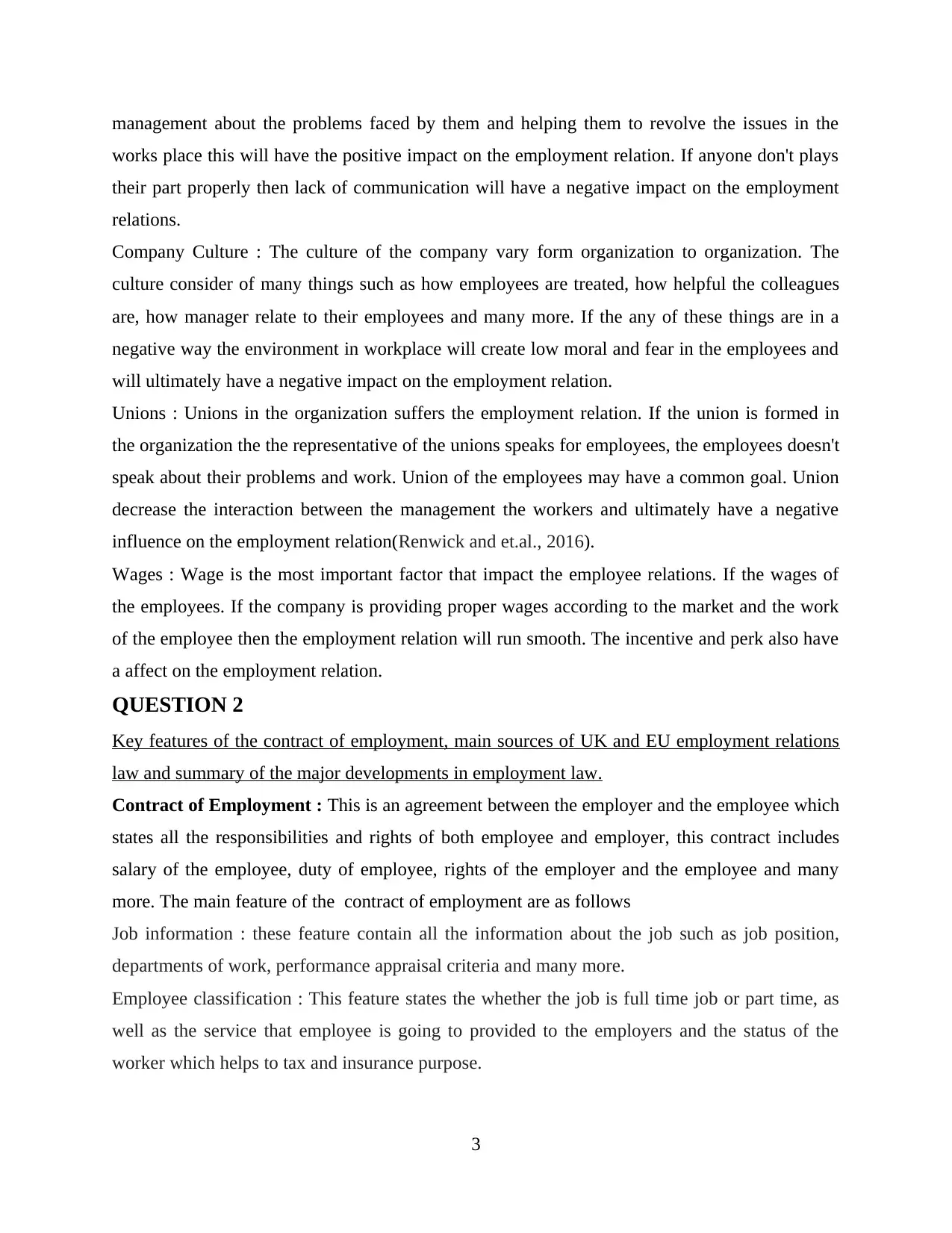
management about the problems faced by them and helping them to revolve the issues in the
works place this will have the positive impact on the employment relation. If anyone don't plays
their part properly then lack of communication will have a negative impact on the employment
relations.
Company Culture : The culture of the company vary form organization to organization. The
culture consider of many things such as how employees are treated, how helpful the colleagues
are, how manager relate to their employees and many more. If the any of these things are in a
negative way the environment in workplace will create low moral and fear in the employees and
will ultimately have a negative impact on the employment relation.
Unions : Unions in the organization suffers the employment relation. If the union is formed in
the organization the the representative of the unions speaks for employees, the employees doesn't
speak about their problems and work. Union of the employees may have a common goal. Union
decrease the interaction between the management the workers and ultimately have a negative
influence on the employment relation(Renwick and et.al., 2016).
Wages : Wage is the most important factor that impact the employee relations. If the wages of
the employees. If the company is providing proper wages according to the market and the work
of the employee then the employment relation will run smooth. The incentive and perk also have
a affect on the employment relation.
QUESTION 2
Key features of the contract of employment, main sources of UK and EU employment relations
law and summary of the major developments in employment law.
Contract of Employment : This is an agreement between the employer and the employee which
states all the responsibilities and rights of both employee and employer, this contract includes
salary of the employee, duty of employee, rights of the employer and the employee and many
more. The main feature of the contract of employment are as follows
Job information : these feature contain all the information about the job such as job position,
departments of work, performance appraisal criteria and many more.
Employee classification : This feature states the whether the job is full time job or part time, as
well as the service that employee is going to provided to the employers and the status of the
worker which helps to tax and insurance purpose.
3
works place this will have the positive impact on the employment relation. If anyone don't plays
their part properly then lack of communication will have a negative impact on the employment
relations.
Company Culture : The culture of the company vary form organization to organization. The
culture consider of many things such as how employees are treated, how helpful the colleagues
are, how manager relate to their employees and many more. If the any of these things are in a
negative way the environment in workplace will create low moral and fear in the employees and
will ultimately have a negative impact on the employment relation.
Unions : Unions in the organization suffers the employment relation. If the union is formed in
the organization the the representative of the unions speaks for employees, the employees doesn't
speak about their problems and work. Union of the employees may have a common goal. Union
decrease the interaction between the management the workers and ultimately have a negative
influence on the employment relation(Renwick and et.al., 2016).
Wages : Wage is the most important factor that impact the employee relations. If the wages of
the employees. If the company is providing proper wages according to the market and the work
of the employee then the employment relation will run smooth. The incentive and perk also have
a affect on the employment relation.
QUESTION 2
Key features of the contract of employment, main sources of UK and EU employment relations
law and summary of the major developments in employment law.
Contract of Employment : This is an agreement between the employer and the employee which
states all the responsibilities and rights of both employee and employer, this contract includes
salary of the employee, duty of employee, rights of the employer and the employee and many
more. The main feature of the contract of employment are as follows
Job information : these feature contain all the information about the job such as job position,
departments of work, performance appraisal criteria and many more.
Employee classification : This feature states the whether the job is full time job or part time, as
well as the service that employee is going to provided to the employers and the status of the
worker which helps to tax and insurance purpose.
3
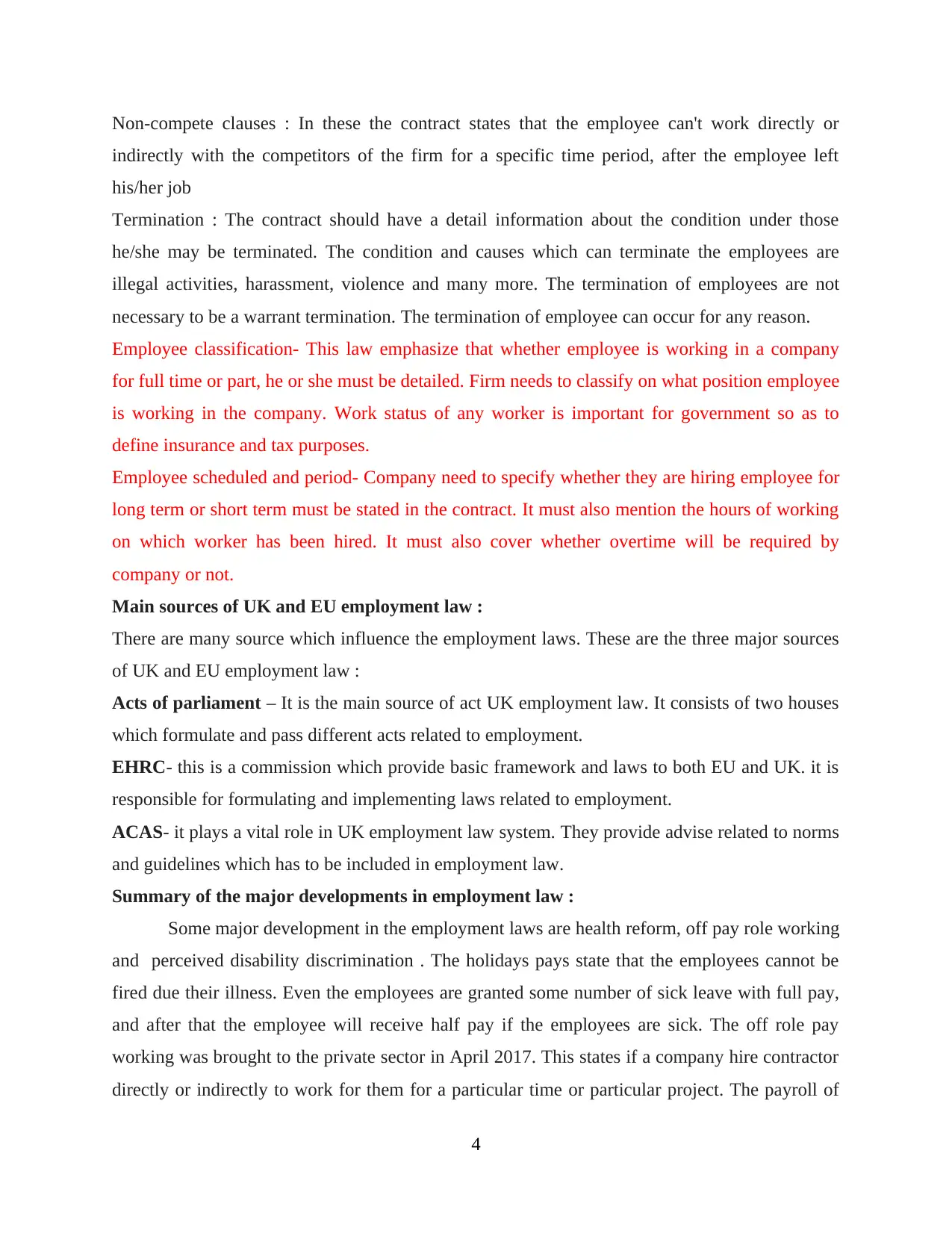
Non-compete clauses : In these the contract states that the employee can't work directly or
indirectly with the competitors of the firm for a specific time period, after the employee left
his/her job
Termination : The contract should have a detail information about the condition under those
he/she may be terminated. The condition and causes which can terminate the employees are
illegal activities, harassment, violence and many more. The termination of employees are not
necessary to be a warrant termination. The termination of employee can occur for any reason.
Employee classification- This law emphasize that whether employee is working in a company
for full time or part, he or she must be detailed. Firm needs to classify on what position employee
is working in the company. Work status of any worker is important for government so as to
define insurance and tax purposes.
Employee scheduled and period- Company need to specify whether they are hiring employee for
long term or short term must be stated in the contract. It must also mention the hours of working
on which worker has been hired. It must also cover whether overtime will be required by
company or not.
Main sources of UK and EU employment law :
There are many source which influence the employment laws. These are the three major sources
of UK and EU employment law :
Acts of parliament – It is the main source of act UK employment law. It consists of two houses
which formulate and pass different acts related to employment.
EHRC- this is a commission which provide basic framework and laws to both EU and UK. it is
responsible for formulating and implementing laws related to employment.
ACAS- it plays a vital role in UK employment law system. They provide advise related to norms
and guidelines which has to be included in employment law.
Summary of the major developments in employment law :
Some major development in the employment laws are health reform, off pay role working
and perceived disability discrimination . The holidays pays state that the employees cannot be
fired due their illness. Even the employees are granted some number of sick leave with full pay,
and after that the employee will receive half pay if the employees are sick. The off role pay
working was brought to the private sector in April 2017. This states if a company hire contractor
directly or indirectly to work for them for a particular time or particular project. The payroll of
4
indirectly with the competitors of the firm for a specific time period, after the employee left
his/her job
Termination : The contract should have a detail information about the condition under those
he/she may be terminated. The condition and causes which can terminate the employees are
illegal activities, harassment, violence and many more. The termination of employees are not
necessary to be a warrant termination. The termination of employee can occur for any reason.
Employee classification- This law emphasize that whether employee is working in a company
for full time or part, he or she must be detailed. Firm needs to classify on what position employee
is working in the company. Work status of any worker is important for government so as to
define insurance and tax purposes.
Employee scheduled and period- Company need to specify whether they are hiring employee for
long term or short term must be stated in the contract. It must also mention the hours of working
on which worker has been hired. It must also cover whether overtime will be required by
company or not.
Main sources of UK and EU employment law :
There are many source which influence the employment laws. These are the three major sources
of UK and EU employment law :
Acts of parliament – It is the main source of act UK employment law. It consists of two houses
which formulate and pass different acts related to employment.
EHRC- this is a commission which provide basic framework and laws to both EU and UK. it is
responsible for formulating and implementing laws related to employment.
ACAS- it plays a vital role in UK employment law system. They provide advise related to norms
and guidelines which has to be included in employment law.
Summary of the major developments in employment law :
Some major development in the employment laws are health reform, off pay role working
and perceived disability discrimination . The holidays pays state that the employees cannot be
fired due their illness. Even the employees are granted some number of sick leave with full pay,
and after that the employee will receive half pay if the employees are sick. The off role pay
working was brought to the private sector in April 2017. This states if a company hire contractor
directly or indirectly to work for them for a particular time or particular project. The payroll of
4
⊘ This is a preview!⊘
Do you want full access?
Subscribe today to unlock all pages.

Trusted by 1+ million students worldwide
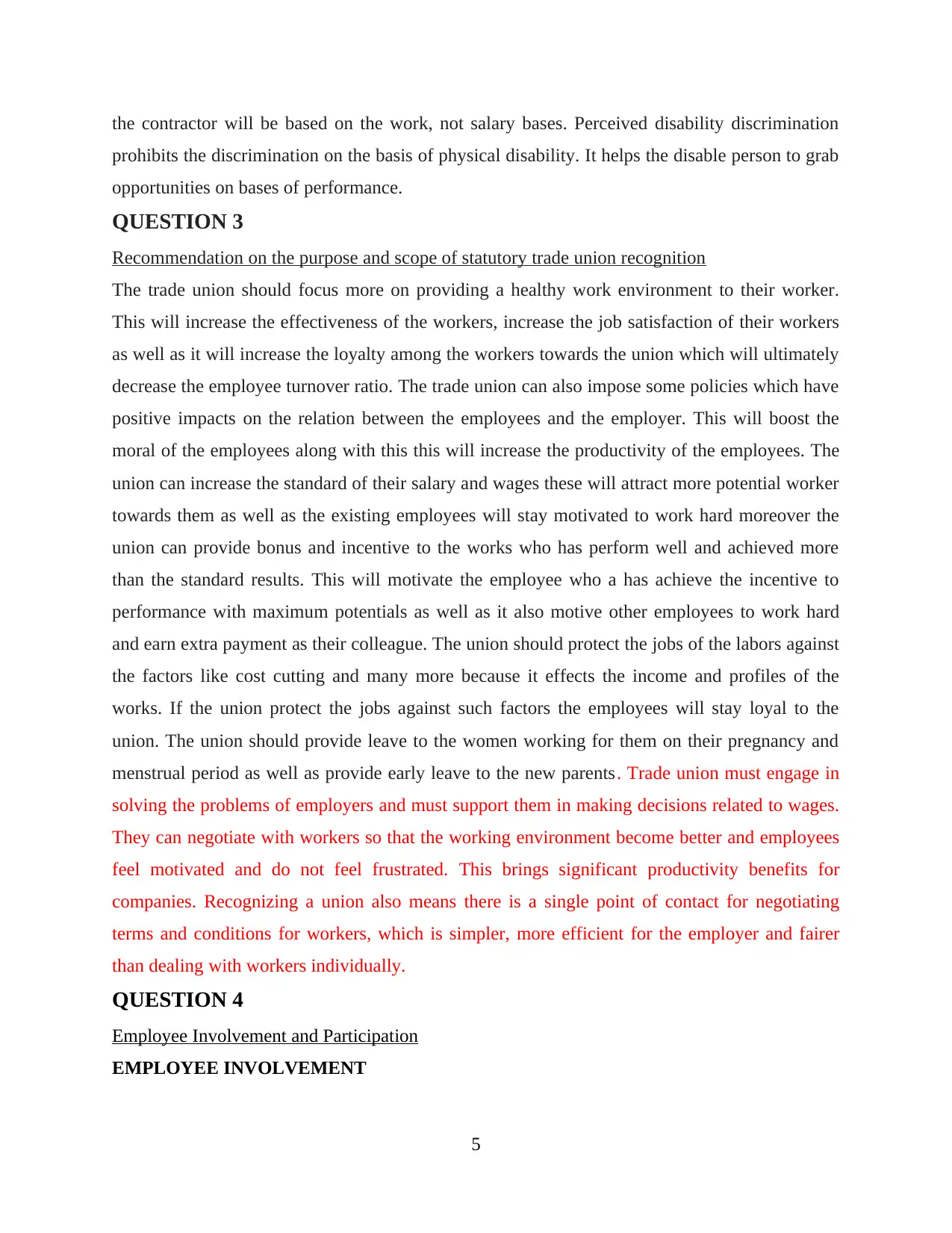
the contractor will be based on the work, not salary bases. Perceived disability discrimination
prohibits the discrimination on the basis of physical disability. It helps the disable person to grab
opportunities on bases of performance.
QUESTION 3
Recommendation on the purpose and scope of statutory trade union recognition
The trade union should focus more on providing a healthy work environment to their worker.
This will increase the effectiveness of the workers, increase the job satisfaction of their workers
as well as it will increase the loyalty among the workers towards the union which will ultimately
decrease the employee turnover ratio. The trade union can also impose some policies which have
positive impacts on the relation between the employees and the employer. This will boost the
moral of the employees along with this this will increase the productivity of the employees. The
union can increase the standard of their salary and wages these will attract more potential worker
towards them as well as the existing employees will stay motivated to work hard moreover the
union can provide bonus and incentive to the works who has perform well and achieved more
than the standard results. This will motivate the employee who a has achieve the incentive to
performance with maximum potentials as well as it also motive other employees to work hard
and earn extra payment as their colleague. The union should protect the jobs of the labors against
the factors like cost cutting and many more because it effects the income and profiles of the
works. If the union protect the jobs against such factors the employees will stay loyal to the
union. The union should provide leave to the women working for them on their pregnancy and
menstrual period as well as provide early leave to the new parents. Trade union must engage in
solving the problems of employers and must support them in making decisions related to wages.
They can negotiate with workers so that the working environment become better and employees
feel motivated and do not feel frustrated. This brings significant productivity benefits for
companies. Recognizing a union also means there is a single point of contact for negotiating
terms and conditions for workers, which is simpler, more efficient for the employer and fairer
than dealing with workers individually.
QUESTION 4
Employee Involvement and Participation
EMPLOYEE INVOLVEMENT
5
prohibits the discrimination on the basis of physical disability. It helps the disable person to grab
opportunities on bases of performance.
QUESTION 3
Recommendation on the purpose and scope of statutory trade union recognition
The trade union should focus more on providing a healthy work environment to their worker.
This will increase the effectiveness of the workers, increase the job satisfaction of their workers
as well as it will increase the loyalty among the workers towards the union which will ultimately
decrease the employee turnover ratio. The trade union can also impose some policies which have
positive impacts on the relation between the employees and the employer. This will boost the
moral of the employees along with this this will increase the productivity of the employees. The
union can increase the standard of their salary and wages these will attract more potential worker
towards them as well as the existing employees will stay motivated to work hard moreover the
union can provide bonus and incentive to the works who has perform well and achieved more
than the standard results. This will motivate the employee who a has achieve the incentive to
performance with maximum potentials as well as it also motive other employees to work hard
and earn extra payment as their colleague. The union should protect the jobs of the labors against
the factors like cost cutting and many more because it effects the income and profiles of the
works. If the union protect the jobs against such factors the employees will stay loyal to the
union. The union should provide leave to the women working for them on their pregnancy and
menstrual period as well as provide early leave to the new parents. Trade union must engage in
solving the problems of employers and must support them in making decisions related to wages.
They can negotiate with workers so that the working environment become better and employees
feel motivated and do not feel frustrated. This brings significant productivity benefits for
companies. Recognizing a union also means there is a single point of contact for negotiating
terms and conditions for workers, which is simpler, more efficient for the employer and fairer
than dealing with workers individually.
QUESTION 4
Employee Involvement and Participation
EMPLOYEE INVOLVEMENT
5
Paraphrase This Document
Need a fresh take? Get an instant paraphrase of this document with our AI Paraphraser

Employee Involvement is a method through which employee have an influence on the
decision making at workplace that will impact their jobs. It is not a tool or technique but a
philosophy that how the employee's can bring in the improvement and success in their
organisation. By involving employee's, the organisation can create an empowering and
continuously improving workplace. This brings commitment in employee's, helps in retaining the
best employee's and creates an environment that motivates them to be contributing in the
organizations success. Employee Involvement can be through regular improvement meetings,
suggestion methods, Kaizen events, corrective action methods and discussions with superiors.
This is a Participative approach that use the employee's inputs to enhance their
commitment in the success of the business. The employee's involvement helps organisation in
achieving their mission, vision and objectives by using their creative ideas, efforts and expertise
towards making decisions and problem solving. Continuous involvement of employee's in
determining how work should be done, giving recommendations for improving, setting
objectives, monitoring and controlling their performance.
The key features of employee involvement is this involves mental and emotional
contribution of the employee's. It brings the spirit of working in a team. It is a method to
motivate the employee's. The person can evaluate their own positive and negative aspects.
EMPLOYEE PARTICIPATION
Employee Participation means the activities in which the employee's take part in a team
to successfully achieve the business goals and objectives. When employee's work in a team every
individual's participation brings an advantage of their unique skills, employee moral is boost.
Participation refers to actual activities of the business that employee perform. This creates a team
approach which includes a group of people that helps in completing the project by using their
different skill sets to attain the business objectives. In employee participation, a individual shares
the idea with others. They form a team and are held responsible for the completion of the project
or the tasks. The team develops a forum where employee's can give suggestions and ideas to
make any changes in the project that will bring more efficiency and effectiveness. So by this
method employee's are motivated and encouraged to participate although their involvement level
is major or minor. In this way the employee's who like their jobs are more motivated as they will
feel confident that they are a part of the process. It will reduce employee turnover as they will be
happy and comfortable working around in the organisation and will reduce the hiring cost of new
6
decision making at workplace that will impact their jobs. It is not a tool or technique but a
philosophy that how the employee's can bring in the improvement and success in their
organisation. By involving employee's, the organisation can create an empowering and
continuously improving workplace. This brings commitment in employee's, helps in retaining the
best employee's and creates an environment that motivates them to be contributing in the
organizations success. Employee Involvement can be through regular improvement meetings,
suggestion methods, Kaizen events, corrective action methods and discussions with superiors.
This is a Participative approach that use the employee's inputs to enhance their
commitment in the success of the business. The employee's involvement helps organisation in
achieving their mission, vision and objectives by using their creative ideas, efforts and expertise
towards making decisions and problem solving. Continuous involvement of employee's in
determining how work should be done, giving recommendations for improving, setting
objectives, monitoring and controlling their performance.
The key features of employee involvement is this involves mental and emotional
contribution of the employee's. It brings the spirit of working in a team. It is a method to
motivate the employee's. The person can evaluate their own positive and negative aspects.
EMPLOYEE PARTICIPATION
Employee Participation means the activities in which the employee's take part in a team
to successfully achieve the business goals and objectives. When employee's work in a team every
individual's participation brings an advantage of their unique skills, employee moral is boost.
Participation refers to actual activities of the business that employee perform. This creates a team
approach which includes a group of people that helps in completing the project by using their
different skill sets to attain the business objectives. In employee participation, a individual shares
the idea with others. They form a team and are held responsible for the completion of the project
or the tasks. The team develops a forum where employee's can give suggestions and ideas to
make any changes in the project that will bring more efficiency and effectiveness. So by this
method employee's are motivated and encouraged to participate although their involvement level
is major or minor. In this way the employee's who like their jobs are more motivated as they will
feel confident that they are a part of the process. It will reduce employee turnover as they will be
happy and comfortable working around in the organisation and will reduce the hiring cost of new
6
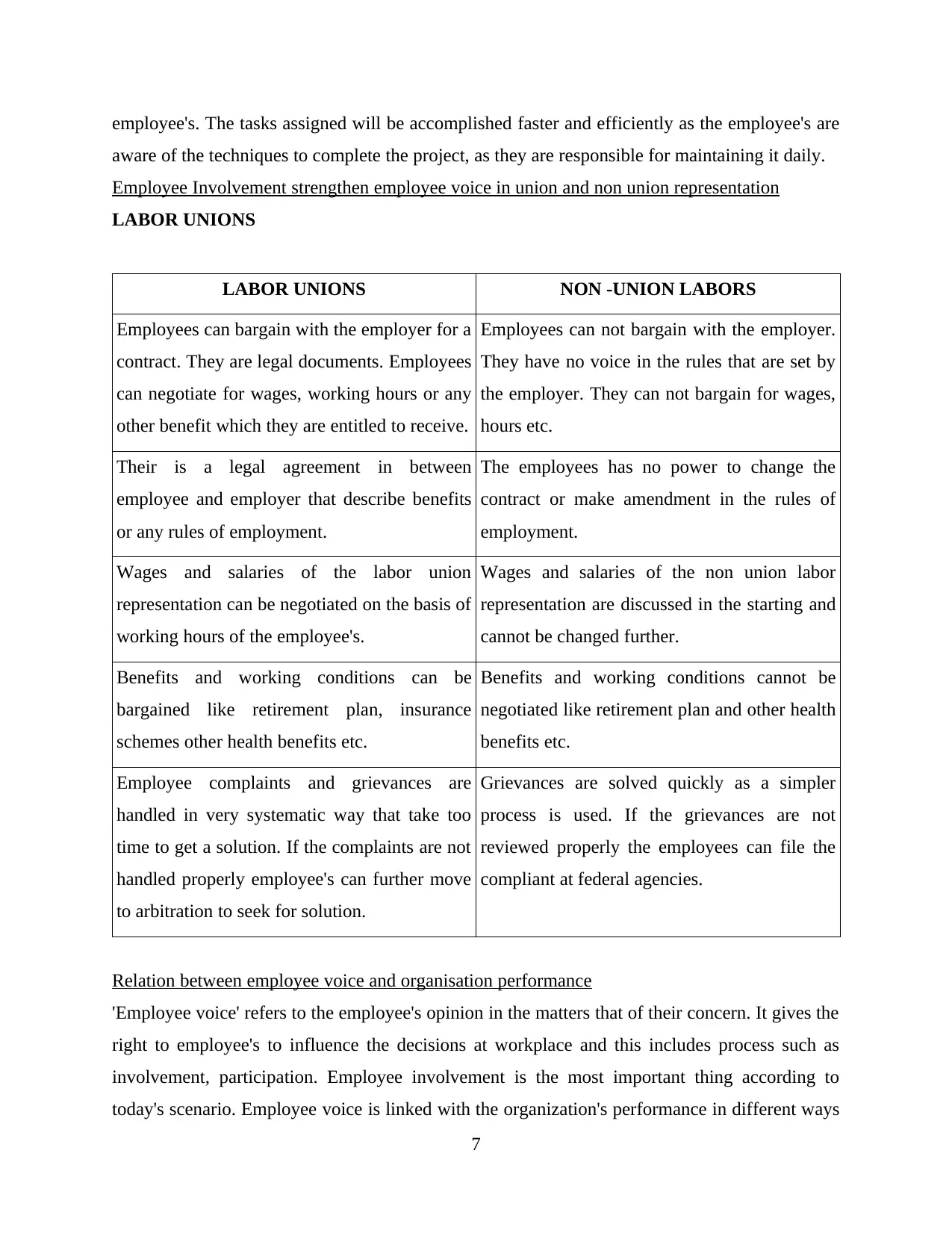
employee's. The tasks assigned will be accomplished faster and efficiently as the employee's are
aware of the techniques to complete the project, as they are responsible for maintaining it daily.
Employee Involvement strengthen employee voice in union and non union representation
LABOR UNIONS
LABOR UNIONS NON -UNION LABORS
Employees can bargain with the employer for a
contract. They are legal documents. Employees
can negotiate for wages, working hours or any
other benefit which they are entitled to receive.
Employees can not bargain with the employer.
They have no voice in the rules that are set by
the employer. They can not bargain for wages,
hours etc.
Their is a legal agreement in between
employee and employer that describe benefits
or any rules of employment.
The employees has no power to change the
contract or make amendment in the rules of
employment.
Wages and salaries of the labor union
representation can be negotiated on the basis of
working hours of the employee's.
Wages and salaries of the non union labor
representation are discussed in the starting and
cannot be changed further.
Benefits and working conditions can be
bargained like retirement plan, insurance
schemes other health benefits etc.
Benefits and working conditions cannot be
negotiated like retirement plan and other health
benefits etc.
Employee complaints and grievances are
handled in very systematic way that take too
time to get a solution. If the complaints are not
handled properly employee's can further move
to arbitration to seek for solution.
Grievances are solved quickly as a simpler
process is used. If the grievances are not
reviewed properly the employees can file the
compliant at federal agencies.
Relation between employee voice and organisation performance
'Employee voice' refers to the employee's opinion in the matters that of their concern. It gives the
right to employee's to influence the decisions at workplace and this includes process such as
involvement, participation. Employee involvement is the most important thing according to
today's scenario. Employee voice is linked with the organization's performance in different ways
7
aware of the techniques to complete the project, as they are responsible for maintaining it daily.
Employee Involvement strengthen employee voice in union and non union representation
LABOR UNIONS
LABOR UNIONS NON -UNION LABORS
Employees can bargain with the employer for a
contract. They are legal documents. Employees
can negotiate for wages, working hours or any
other benefit which they are entitled to receive.
Employees can not bargain with the employer.
They have no voice in the rules that are set by
the employer. They can not bargain for wages,
hours etc.
Their is a legal agreement in between
employee and employer that describe benefits
or any rules of employment.
The employees has no power to change the
contract or make amendment in the rules of
employment.
Wages and salaries of the labor union
representation can be negotiated on the basis of
working hours of the employee's.
Wages and salaries of the non union labor
representation are discussed in the starting and
cannot be changed further.
Benefits and working conditions can be
bargained like retirement plan, insurance
schemes other health benefits etc.
Benefits and working conditions cannot be
negotiated like retirement plan and other health
benefits etc.
Employee complaints and grievances are
handled in very systematic way that take too
time to get a solution. If the complaints are not
handled properly employee's can further move
to arbitration to seek for solution.
Grievances are solved quickly as a simpler
process is used. If the grievances are not
reviewed properly the employees can file the
compliant at federal agencies.
Relation between employee voice and organisation performance
'Employee voice' refers to the employee's opinion in the matters that of their concern. It gives the
right to employee's to influence the decisions at workplace and this includes process such as
involvement, participation. Employee involvement is the most important thing according to
today's scenario. Employee voice is linked with the organization's performance in different ways
7
⊘ This is a preview!⊘
Do you want full access?
Subscribe today to unlock all pages.

Trusted by 1+ million students worldwide
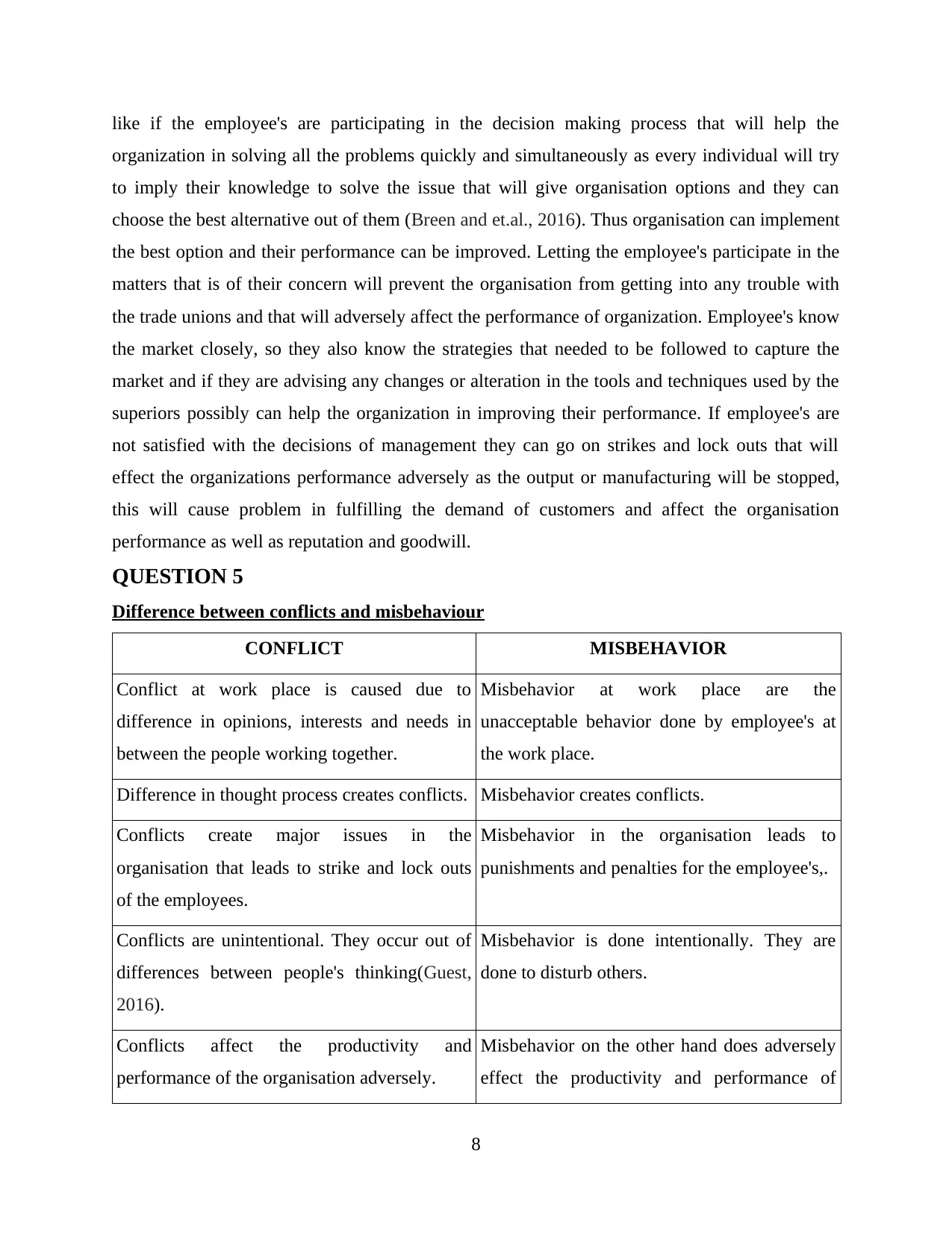
like if the employee's are participating in the decision making process that will help the
organization in solving all the problems quickly and simultaneously as every individual will try
to imply their knowledge to solve the issue that will give organisation options and they can
choose the best alternative out of them (Breen and et.al., 2016). Thus organisation can implement
the best option and their performance can be improved. Letting the employee's participate in the
matters that is of their concern will prevent the organisation from getting into any trouble with
the trade unions and that will adversely affect the performance of organization. Employee's know
the market closely, so they also know the strategies that needed to be followed to capture the
market and if they are advising any changes or alteration in the tools and techniques used by the
superiors possibly can help the organization in improving their performance. If employee's are
not satisfied with the decisions of management they can go on strikes and lock outs that will
effect the organizations performance adversely as the output or manufacturing will be stopped,
this will cause problem in fulfilling the demand of customers and affect the organisation
performance as well as reputation and goodwill.
QUESTION 5
Difference between conflicts and misbehaviour
CONFLICT MISBEHAVIOR
Conflict at work place is caused due to
difference in opinions, interests and needs in
between the people working together.
Misbehavior at work place are the
unacceptable behavior done by employee's at
the work place.
Difference in thought process creates conflicts. Misbehavior creates conflicts.
Conflicts create major issues in the
organisation that leads to strike and lock outs
of the employees.
Misbehavior in the organisation leads to
punishments and penalties for the employee's,.
Conflicts are unintentional. They occur out of
differences between people's thinking(Guest,
2016).
Misbehavior is done intentionally. They are
done to disturb others.
Conflicts affect the productivity and
performance of the organisation adversely.
Misbehavior on the other hand does adversely
effect the productivity and performance of
8
organization in solving all the problems quickly and simultaneously as every individual will try
to imply their knowledge to solve the issue that will give organisation options and they can
choose the best alternative out of them (Breen and et.al., 2016). Thus organisation can implement
the best option and their performance can be improved. Letting the employee's participate in the
matters that is of their concern will prevent the organisation from getting into any trouble with
the trade unions and that will adversely affect the performance of organization. Employee's know
the market closely, so they also know the strategies that needed to be followed to capture the
market and if they are advising any changes or alteration in the tools and techniques used by the
superiors possibly can help the organization in improving their performance. If employee's are
not satisfied with the decisions of management they can go on strikes and lock outs that will
effect the organizations performance adversely as the output or manufacturing will be stopped,
this will cause problem in fulfilling the demand of customers and affect the organisation
performance as well as reputation and goodwill.
QUESTION 5
Difference between conflicts and misbehaviour
CONFLICT MISBEHAVIOR
Conflict at work place is caused due to
difference in opinions, interests and needs in
between the people working together.
Misbehavior at work place are the
unacceptable behavior done by employee's at
the work place.
Difference in thought process creates conflicts. Misbehavior creates conflicts.
Conflicts create major issues in the
organisation that leads to strike and lock outs
of the employees.
Misbehavior in the organisation leads to
punishments and penalties for the employee's,.
Conflicts are unintentional. They occur out of
differences between people's thinking(Guest,
2016).
Misbehavior is done intentionally. They are
done to disturb others.
Conflicts affect the productivity and
performance of the organisation adversely.
Misbehavior on the other hand does adversely
effect the productivity and performance of
8
Paraphrase This Document
Need a fresh take? Get an instant paraphrase of this document with our AI Paraphraser
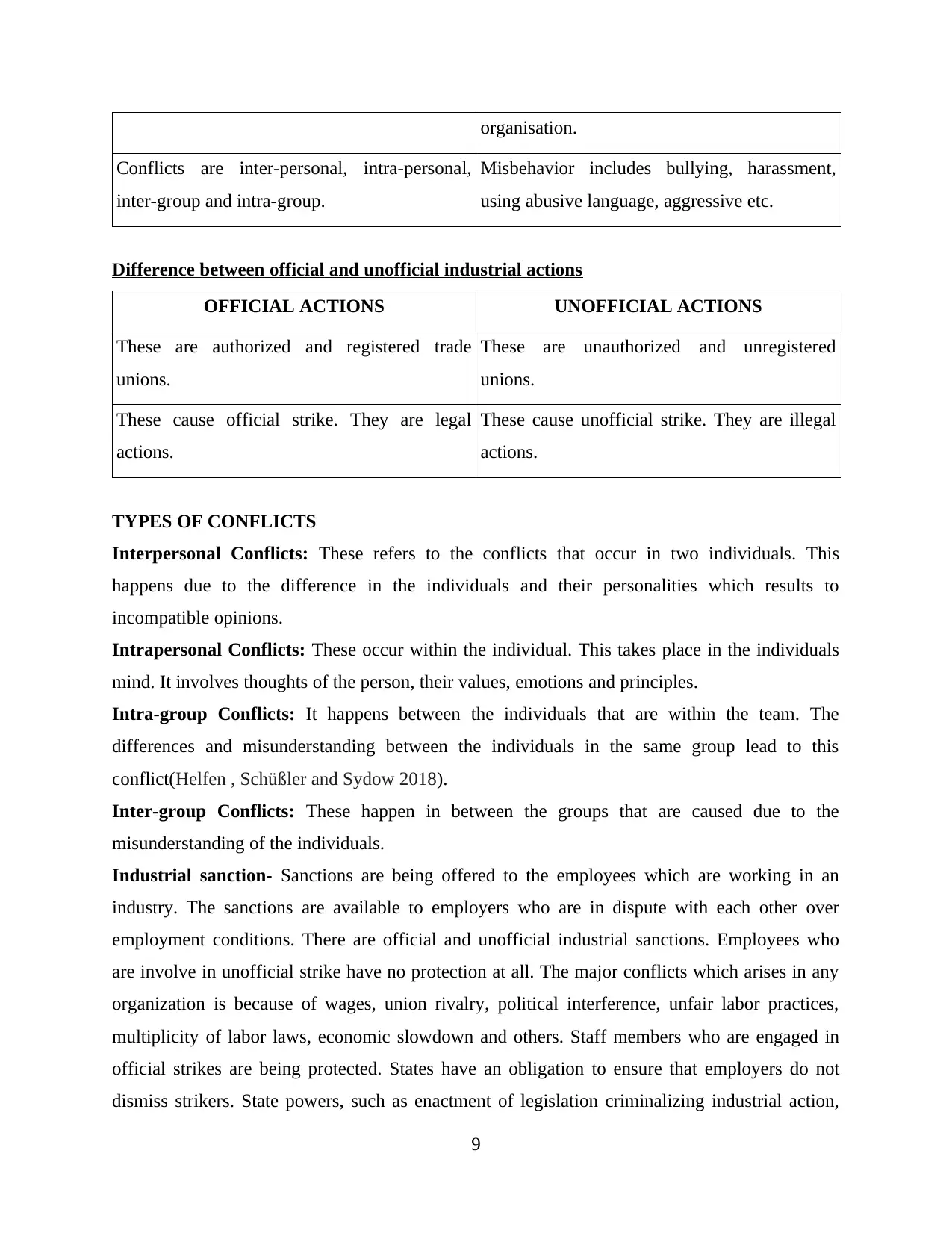
organisation.
Conflicts are inter-personal, intra-personal,
inter-group and intra-group.
Misbehavior includes bullying, harassment,
using abusive language, aggressive etc.
Difference between official and unofficial industrial actions
OFFICIAL ACTIONS UNOFFICIAL ACTIONS
These are authorized and registered trade
unions.
These are unauthorized and unregistered
unions.
These cause official strike. They are legal
actions.
These cause unofficial strike. They are illegal
actions.
TYPES OF CONFLICTS
Interpersonal Conflicts: These refers to the conflicts that occur in two individuals. This
happens due to the difference in the individuals and their personalities which results to
incompatible opinions.
Intrapersonal Conflicts: These occur within the individual. This takes place in the individuals
mind. It involves thoughts of the person, their values, emotions and principles.
Intra-group Conflicts: It happens between the individuals that are within the team. The
differences and misunderstanding between the individuals in the same group lead to this
conflict(Helfen , Schüßler and Sydow 2018).
Inter-group Conflicts: These happen in between the groups that are caused due to the
misunderstanding of the individuals.
Industrial sanction- Sanctions are being offered to the employees which are working in an
industry. The sanctions are available to employers who are in dispute with each other over
employment conditions. There are official and unofficial industrial sanctions. Employees who
are involve in unofficial strike have no protection at all. The major conflicts which arises in any
organization is because of wages, union rivalry, political interference, unfair labor practices,
multiplicity of labor laws, economic slowdown and others. Staff members who are engaged in
official strikes are being protected. States have an obligation to ensure that employers do not
dismiss strikers. State powers, such as enactment of legislation criminalizing industrial action,
9
Conflicts are inter-personal, intra-personal,
inter-group and intra-group.
Misbehavior includes bullying, harassment,
using abusive language, aggressive etc.
Difference between official and unofficial industrial actions
OFFICIAL ACTIONS UNOFFICIAL ACTIONS
These are authorized and registered trade
unions.
These are unauthorized and unregistered
unions.
These cause official strike. They are legal
actions.
These cause unofficial strike. They are illegal
actions.
TYPES OF CONFLICTS
Interpersonal Conflicts: These refers to the conflicts that occur in two individuals. This
happens due to the difference in the individuals and their personalities which results to
incompatible opinions.
Intrapersonal Conflicts: These occur within the individual. This takes place in the individuals
mind. It involves thoughts of the person, their values, emotions and principles.
Intra-group Conflicts: It happens between the individuals that are within the team. The
differences and misunderstanding between the individuals in the same group lead to this
conflict(Helfen , Schüßler and Sydow 2018).
Inter-group Conflicts: These happen in between the groups that are caused due to the
misunderstanding of the individuals.
Industrial sanction- Sanctions are being offered to the employees which are working in an
industry. The sanctions are available to employers who are in dispute with each other over
employment conditions. There are official and unofficial industrial sanctions. Employees who
are involve in unofficial strike have no protection at all. The major conflicts which arises in any
organization is because of wages, union rivalry, political interference, unfair labor practices,
multiplicity of labor laws, economic slowdown and others. Staff members who are engaged in
official strikes are being protected. States have an obligation to ensure that employers do not
dismiss strikers. State powers, such as enactment of legislation criminalizing industrial action,
9
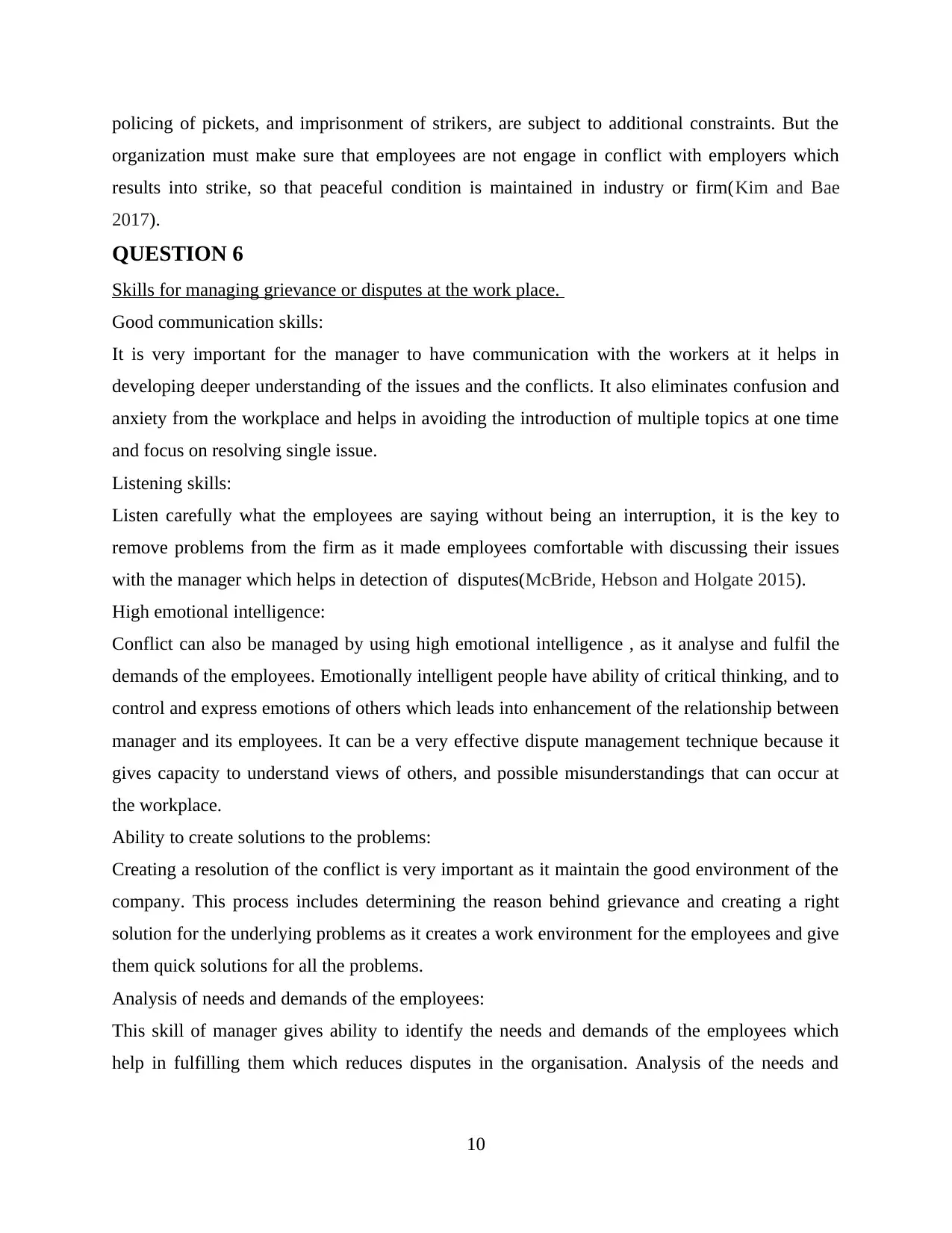
policing of pickets, and imprisonment of strikers, are subject to additional constraints. But the
organization must make sure that employees are not engage in conflict with employers which
results into strike, so that peaceful condition is maintained in industry or firm(Kim and Bae
2017).
QUESTION 6
Skills for managing grievance or disputes at the work place.
Good communication skills:
It is very important for the manager to have communication with the workers at it helps in
developing deeper understanding of the issues and the conflicts. It also eliminates confusion and
anxiety from the workplace and helps in avoiding the introduction of multiple topics at one time
and focus on resolving single issue.
Listening skills:
Listen carefully what the employees are saying without being an interruption, it is the key to
remove problems from the firm as it made employees comfortable with discussing their issues
with the manager which helps in detection of disputes(McBride, Hebson and Holgate 2015).
High emotional intelligence:
Conflict can also be managed by using high emotional intelligence , as it analyse and fulfil the
demands of the employees. Emotionally intelligent people have ability of critical thinking, and to
control and express emotions of others which leads into enhancement of the relationship between
manager and its employees. It can be a very effective dispute management technique because it
gives capacity to understand views of others, and possible misunderstandings that can occur at
the workplace.
Ability to create solutions to the problems:
Creating a resolution of the conflict is very important as it maintain the good environment of the
company. This process includes determining the reason behind grievance and creating a right
solution for the underlying problems as it creates a work environment for the employees and give
them quick solutions for all the problems.
Analysis of needs and demands of the employees:
This skill of manager gives ability to identify the needs and demands of the employees which
help in fulfilling them which reduces disputes in the organisation. Analysis of the needs and
10
organization must make sure that employees are not engage in conflict with employers which
results into strike, so that peaceful condition is maintained in industry or firm(Kim and Bae
2017).
QUESTION 6
Skills for managing grievance or disputes at the work place.
Good communication skills:
It is very important for the manager to have communication with the workers at it helps in
developing deeper understanding of the issues and the conflicts. It also eliminates confusion and
anxiety from the workplace and helps in avoiding the introduction of multiple topics at one time
and focus on resolving single issue.
Listening skills:
Listen carefully what the employees are saying without being an interruption, it is the key to
remove problems from the firm as it made employees comfortable with discussing their issues
with the manager which helps in detection of disputes(McBride, Hebson and Holgate 2015).
High emotional intelligence:
Conflict can also be managed by using high emotional intelligence , as it analyse and fulfil the
demands of the employees. Emotionally intelligent people have ability of critical thinking, and to
control and express emotions of others which leads into enhancement of the relationship between
manager and its employees. It can be a very effective dispute management technique because it
gives capacity to understand views of others, and possible misunderstandings that can occur at
the workplace.
Ability to create solutions to the problems:
Creating a resolution of the conflict is very important as it maintain the good environment of the
company. This process includes determining the reason behind grievance and creating a right
solution for the underlying problems as it creates a work environment for the employees and give
them quick solutions for all the problems.
Analysis of needs and demands of the employees:
This skill of manager gives ability to identify the needs and demands of the employees which
help in fulfilling them which reduces disputes in the organisation. Analysis of the needs and
10
⊘ This is a preview!⊘
Do you want full access?
Subscribe today to unlock all pages.

Trusted by 1+ million students worldwide
1 out of 15
Related Documents
Your All-in-One AI-Powered Toolkit for Academic Success.
+13062052269
info@desklib.com
Available 24*7 on WhatsApp / Email
![[object Object]](/_next/static/media/star-bottom.7253800d.svg)
Unlock your academic potential
Copyright © 2020–2025 A2Z Services. All Rights Reserved. Developed and managed by ZUCOL.



